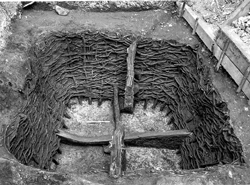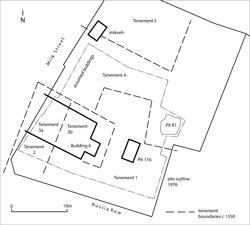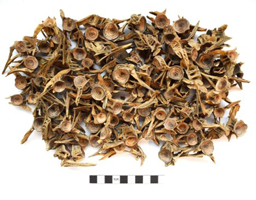The search for Jewish food in London's medieval Jewry
An analysis of the animal bones from 10th to 13th century pits at Milk Street (MKL76)
John Schofield and Rebecca Gordon
In 1976–7, the Department of Urban Archaeology of the Museum of London carried out excavations at 1–6 Milk Street, EC2 (site MLK76) which revealed several medieval properties and 121 pits and from the late 9th century to the 13th century. The pits contained a wide array of archaeological finds including pottery, leather shoes, wooden bowls, metal and bone objects, textiles (linen, cloth and silk) and animal bones. The details of the excavation were published in Transactions 41 (Schofield et al 1990).
In December 2019, LAMAS granted John Schofield and Rebecca Gordon £3,500 to publish all the medieval faunal collection from the Milk Street excavation to follow and match the original report of 1990. Rebecca has analysed the animal bones from one of the most important pits, Pit 81 (on the plan, Fig 1; what it looked like, Fig 2) on a grant from the City of London Archaeological Trust (CoLAT). It was evident that she should continue with the analysis of all the animal bones from the 121 pits.
There are two objectives: to study the animal bones in the pits, to observe characteristics and changes in human diet; and to see if we can identify Jewish food practices (sometimes called foodways).
 Milk Street is within the heart of London's medieval Jewry, north of Cheapside. Jews had taken residence in this area by the 12th century. The boundary of the London Jewry was never fixed and Jews and Christians coexisted within it until the expulsion of the Jews in 1290. Three tenements discovered in the 1976–7 excavation were occupied by Jewish families in the 13th century and possibly before (Schofield et al 1990, 131–44). After the excavation and during the redevelopment of the building constructed on the site in 1978, a mikveh or Jewish ritual bath was discovered which belonged to one of the Jewish families on the street (Blair et al 2001; its position is shown on Fig 1). This had survived, just outside the area excavated in 1976–7.
Milk Street is within the heart of London's medieval Jewry, north of Cheapside. Jews had taken residence in this area by the 12th century. The boundary of the London Jewry was never fixed and Jews and Christians coexisted within it until the expulsion of the Jews in 1290. Three tenements discovered in the 1976–7 excavation were occupied by Jewish families in the 13th century and possibly before (Schofield et al 1990, 131–44). After the excavation and during the redevelopment of the building constructed on the site in 1978, a mikveh or Jewish ritual bath was discovered which belonged to one of the Jewish families on the street (Blair et al 2001; its position is shown on Fig 1). This had survived, just outside the area excavated in 1976–7.
Archaeological evidence for London's Jewish community has been sparse and the recovery of Jewish material culture from the City has been sporadic. Surprisingly, the potential of faunal remains to detect Jewish dietary practices remains to be fully explored using assemblages excavated in London. Analysis of faunal remains from European medieval sites with Jewish populations have shown how animal bones can be a useful indicator for Jewish occupation. This is because the slaughter, preparation and consumption of meat must adhere to the laws of kashrut to be considered as kosher (fit for Jewish consumption) which includes the exclusion of, for example pork, rabbit, horse, eel, shellfish and hindlimbs of the main domesticates (unless the latter have been processed by a kosher butcher).
The LAMAS grant will allow us to determine what Jewish and Christian Londoners ate in the 9th to 13th centuries, and the analysis will note the bones of fish (figure 3), pets, vermin, and exotic species.
The recording of the bones will be undertaken by Dr Rebecca Gordon. She completed her PhD in zooarchaeology at the School of Archaeology and Ancient History, University of Leicester in 2015, and is currently a freelance zooarchaeologist and independent researcher.
John Schofield will provide the wider context for the study; he was the original site supervisor for this part of the sequence (the post-Roman) on the 1976–7 excavation
Further Reading
Blair, I, Hillaby, J, Howell, I, Sermon, R, and Watson, B, 2001 'Two medieval Jewish baths – mikva'ot – found at Gresham Street and Milk Street in London', Trans London Middlesex Archaeol Soc 52, 127–38
Schofield, J, Allen, P, & Taylor, C, 1990 'Medieval buildings and property development in the area of Cheapside', Trans London Middlesex Archaeol Soc 41, 39–238




